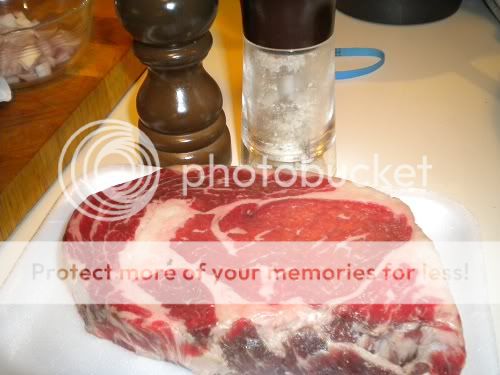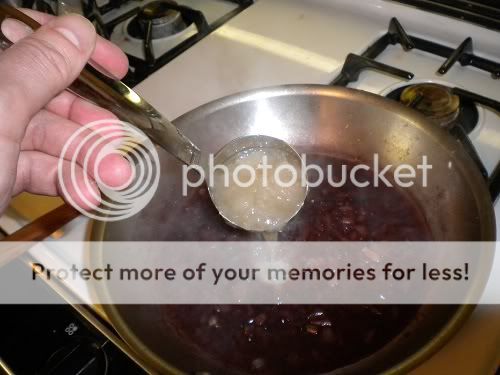Gentlemen, here is my standard pan sauce for a steak. You can use a nicely marbled ribeye or new york, but go with choice. Save the dry aged prime for by itself. Also "flatiron" or "hanger" steaks work great. These are your classic French bistro cuts. Tonight, I went with a moderately marbled USDA choice ribeye.
Seasoning is simply some wet, grey Breton sea salt and my personal blend of 50-50 black-green peppercorns, freshly ground. All purchased at Chicago's Spice House, which has a great mail order business.

The ingredients for the sauce are pretty simple: shallots, flour, chopped flat leaf parsley, good quality unsalted butter, veal stock (low sodium chicken broth can be substituted) and red wine. Keep the latter simple; you want something with high acidity, low alcohol and little to no oak. I went with an inexpensive young ("joven") Rioja that was good enough to drink while cooking the steak and eating the steak.

I love my Lodge cast iron that I've had since college with the seasoning to prove it. I use it for Prime beef. For making a sauce, you don't want cast iron--it reacts with the acid in the wine and gives the sauce a metallic taste. I'm searing the steak in a 12" All Clad LTD saute pan with a nothing more than salt, pepper and a little grapeseed oil (high smoke point/no added flavor).


Cook the steak to a little less than how you want to eat it. Loosely tent it with aluminum foil on a plate while you make the sauce.
Step One: Drain most (but not all) of the rendered beef fat. Lower the heat, put the shallots in and lightly drizzle some grapeseed oil over them. Sprinkle lightly with flour and saute until lightly browned and softened.

Step Two: Pour in roughly 1 cup of the wine and turn the heat up. Use a wooden spoon to scrape all the beefy bits of goodness that stuck to the pan while searing the steak. This is really important (called "deglazing" in cook talk) and will add incredible depth and flavor to the finished sauce.

Step Three: Lightly simmer the wine until reduced to about 1/3 of its original volume, then add the veal stock.


Step Four: stir to combine the stock and then let simmer until the total volume is about 1/4 what you started with. Turn off the heat and let the pan cool for about 30 seconds. Add the first pat of butter and whisk in until just about dissolved, then add the second pat and do the same. Sauce should be cool enough at this point that the butter does not boil or it will separate.

Step Five: When the second pat of butter has dissolved, stir in the chopped parsley.

Eat. For a side, I went with some simple steamed asparagus drizzled with virgin olive oil and a little balsamic. Some locally baked artisan bread and creamery butter from an artisan dairy farmer about an hour outside of Chicago.



And for tonight's movie.

Seasoning is simply some wet, grey Breton sea salt and my personal blend of 50-50 black-green peppercorns, freshly ground. All purchased at Chicago's Spice House, which has a great mail order business.

The ingredients for the sauce are pretty simple: shallots, flour, chopped flat leaf parsley, good quality unsalted butter, veal stock (low sodium chicken broth can be substituted) and red wine. Keep the latter simple; you want something with high acidity, low alcohol and little to no oak. I went with an inexpensive young ("joven") Rioja that was good enough to drink while cooking the steak and eating the steak.

I love my Lodge cast iron that I've had since college with the seasoning to prove it. I use it for Prime beef. For making a sauce, you don't want cast iron--it reacts with the acid in the wine and gives the sauce a metallic taste. I'm searing the steak in a 12" All Clad LTD saute pan with a nothing more than salt, pepper and a little grapeseed oil (high smoke point/no added flavor).


Cook the steak to a little less than how you want to eat it. Loosely tent it with aluminum foil on a plate while you make the sauce.
Step One: Drain most (but not all) of the rendered beef fat. Lower the heat, put the shallots in and lightly drizzle some grapeseed oil over them. Sprinkle lightly with flour and saute until lightly browned and softened.

Step Two: Pour in roughly 1 cup of the wine and turn the heat up. Use a wooden spoon to scrape all the beefy bits of goodness that stuck to the pan while searing the steak. This is really important (called "deglazing" in cook talk) and will add incredible depth and flavor to the finished sauce.

Step Three: Lightly simmer the wine until reduced to about 1/3 of its original volume, then add the veal stock.


Step Four: stir to combine the stock and then let simmer until the total volume is about 1/4 what you started with. Turn off the heat and let the pan cool for about 30 seconds. Add the first pat of butter and whisk in until just about dissolved, then add the second pat and do the same. Sauce should be cool enough at this point that the butter does not boil or it will separate.

Step Five: When the second pat of butter has dissolved, stir in the chopped parsley.

Eat. For a side, I went with some simple steamed asparagus drizzled with virgin olive oil and a little balsamic. Some locally baked artisan bread and creamery butter from an artisan dairy farmer about an hour outside of Chicago.



And for tonight's movie.






 Questioin: where did you purchase the veal stock? I'm also from chicago and have had problems tracking the stuff down.
Questioin: where did you purchase the veal stock? I'm also from chicago and have had problems tracking the stuff down.